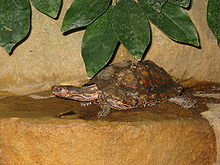Bataguridae
| Geoemydidae | |
|---|---|
 |
|
|
Ornate Wood Turtle Rhinoclemmys pulcherrima manni |
|
| Scientific classification | |
| Kingdom: | Animalia |
| Phylum: | Chordata |
| Class: | Reptilia |
| Order: | Testudines |
| Suborder: | Cryptodira |
| Superfamily: | Testudinoidea |
| Family: |
Geoemydidae Theobald, 1868 |
| Synonyms | |
|
Geoemydidae Theobald 1868:9 |
|
Not to be confused with Geomyidae.
Geoemydidae Theobald 1868:9
Batagurina Gray 1869:185
Bataguridae Gray 1870:17
The Geoemydidae (formerly known as Bataguridae) are one of the largest and most diverse families in the order Testudines (turtles), with about 70 species. The family includes the Eurasian pond and river turtles and Neotropical wood turtles.
Geoemydidae are turtles of various sizes (from about 10 to 80 cm (4 to 30 in) in length) with often a high degree of sexual dimorphism. They usually have webbed toes, and their pelvic girdles articulate with their plastrons flexibly. Their necks are drawn back vertically. Their carapaces have 24 marginal scutes. The plastron is composed of 12 scutes and has no mesoplastron; the pectoral and abdominal scutes contact the marginal scutes.
Some other features include a single articulation between the fifth and sixth cervical vertebrae, the lack of a hyomandibular branch of the facial nerve, and an epipterygoid bone in the skull.
Geoemydidae live in tropics and subtropics of Asia, Europe and North Africa, the only genus in Central and South America is Rhinoclemmys. Their habitats include freshwater ecosystems, coastal marine areas, and tropical forests. Most are herbivorous, but some are omnivorous or carnivorous species. In mating, the males are usually much more active than females. A relatively small number of eggs per clutch is common, produced several times a year. Some species have a temperature-dependent sex determination system, while others possess different sex chromosomes.
...
Wikipedia
